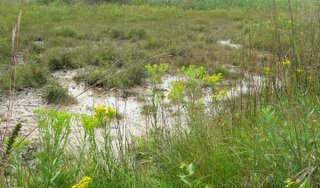Bluff Spring Fen

Bluff Spring Fen
If I have any single professional touchstone, any one particular thing that I consider my life’s work, it’s Bluff Spring Fen. Bluff Spring Fen (or just The Fen) is a roughly 100-acre nature preserve near my home in Elgin, Illinois. My life partner and I have headed up the stewardship team there since the early 1980s.
A fen is a rare type of wetland. Fens form where clay lenses in the soil force underground aquifers to the surface. The rock that these aquifers flow through is limestone, which, by rock standards, is relatively soluble in water. When the water emerges from the ground as springs and seeps, it is mineral rich and highly alkaline. This unusual set of environmental conditions is home to many rare plants and animals with special, though poorly understood, adaptations that allow them to survive there. Over a dozen endangered species can be found at Bluff Spring Fen.

Alkaline Springs
Fens are very rare ecosystems in Illinois. Only about 250 acres remain in the state today. Although it is this rare wetland type that gives the preserve its name, only about 40 of the 100 acres in the preserve is actually fen. Nonetheless, Bluff Spring Fen, along with Lake in the Hills Fen and Boone Creek Fen, is one of the three "big" fens remaining in Illinois today. The rest are scattered in parcels of anywhere from a half to about 10 acres. Most, including the three largest, are located in the watershed of the Fox River, which flows about a mile and a half downstream from Bluff Spring Fen.
One of the things that makes Bluff Spring Fen special is that it is actually a mosaic of different habitats. Botanists recognize a good six or seven different subtypes of fen and wetland within the confines of the preserve. The stewardship team tends to manage these wetland habitats as a unit.
The diversity does not stop there. Bluff Spring Fen is also home to several unusual upland plant and animal communities. The fen is ringed with a series of glacial hills called kames (Scrabble players take note of a great 4-letter word using a k). These are deposits of limestone gravel that formed as the glaciers were receding 10 to 12 thousand years ago. These hills are extremely well drained, and are home to drought adapted plant communities called gravel hill prairies. In drier years, to walk from a kame into the fen is to go from knee high vegetation to grass that is taller than your head within a span of about 15 feet. Like the fen plants, the hill prairie plants are also specialized, and some of the Fen’s endangered species are plants from the gravel hill prairies.

Gravel Hill Prairie
A third major division of the plant communities at Bluff Spring Fen is the oak dominated communities, variously called woodlands or savannas, depending on the amount of tree cover. The plants that grow under the trees are much more shade tolerant than most of the other species on this site. They include many familiar spring wildflowers like trilliums and bloodroots. Most of the oak savannas in Illinois have been destroyed. Indeed, the oaks themselves were the only remaining part of the savannas at Bluff Spring fen until the late 1980s when we started restoring them. Today, a thriving plant community grows beneath the oak trees, but the plants are there almost entirely due to our seeding efforts.

Oak Woodland
The fourth and final major plant community at Bluff Spring Fen is mesic prairie. Mesic means neither really wet nor really dry, but in the middle of the moisture gradient. Less than 1/10 of 1% of the original mesic prairie in Illinois survives today. Sadly, the mesic prairie at Bluff Spring Fen is no exception. All of it was converted to farmland sometime before the 1930s. We have done a lot of work to attempt to recreate the mesic prairie, and about 15 acres that was formerly farmland and pasture is now a native plant matrix that, like prairie, is dominated by grasses. You don’t have to be a trained botanist to see that it isn’t yet really prairie. Still the management team at the fen hopes that by continuing our management practices (particularly burning and seeding with native species), over time the land will come to resemble a real mesic prairie.

Mesic Prairie Restoration
Labels: Bluff Spring Fen, Ecosystems, Prairie Restoration


5 Comments:
thank you!
for years you have been describing the Fen in bits and pieces and now I have it nicely done in one entry a sort of Fen 101.
Are there any Fens in Costa Rica?
Hi Michael,
I don't think that there are fens in Costa Rica. Fens are a temperate rather than tropical ecosystem.
What is the difference between a kame and a loess?
Loess refers to a type of soil deposition. People don't usually refer to "a loess" for similar reasons that they don't refer to "a mud". Loess is fine grained and typically deposited by wind.
A kame is a physical structure. Most look like conical hills. The soil that makes up kames is deposited by water, specifically, glacial meltwater. It's also unsorted gravel, meaning that the individual particles range in size from tiny grains of sand to rocks the size of your fist or larger.
This comment has been removed by a blog administrator.
Post a Comment
<< Home